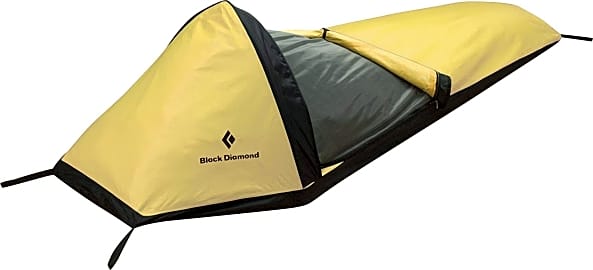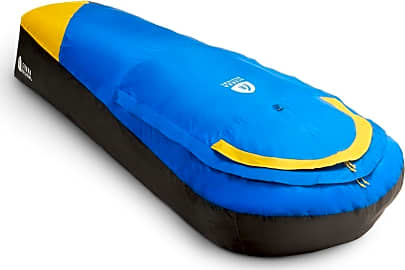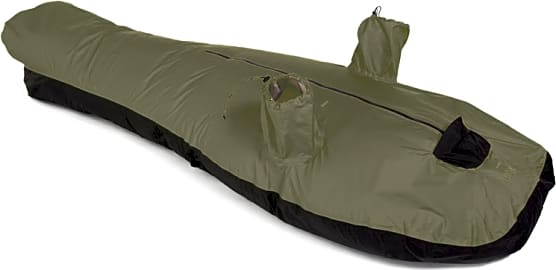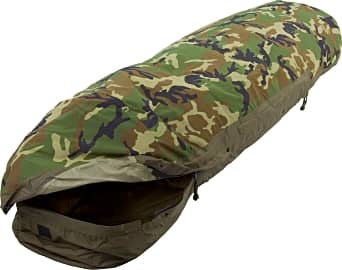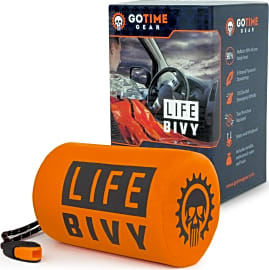The 8 Best Bivy Sacks

This wiki has been updated 37 times since it was first published in September of 2015. Bivy sacks are, essentially, waterproof sleeping bags, and are among the simplest forms of wilderness shelter, although for most campers, they take some getting used to. Because of their minimal weight and bulk, and their close fit to your body, they're popular among advanced backpackers on cold-weather and high-altitude trips, and they could save a life in an emergency. When users buy our independently chosen editorial picks, we may earn commissions to help fund the Wiki.
Editor's Notes
April 23, 2021:
Of the three general types of bivy, hooped models like the Black Diamond Big Wall and Outdoor Research Interstellar are by far the most comfortable. These were also two of our most recent additions, and campers and climbers agree that they both make great sleep setups.
The other general variety is the insulated backpacking bivy that doesn't have a hoop or netting. The Rab Andes is the heavy-hitter of this category and the Tennier US Army Camo is a hardwearing, if somewhat overly heavy option. Most users, though, will appreciate the Sierra Designs Backcountry, which is a little bit lighter and easier to manage.
Finally, there are some great ultralight and emergency models worth mentioning. The RAB Survival Zone Lite is our favorite for minimalist backpacking, and the Go Time Gear Life is good for keeping in your trunk or emergency kit.
February 07, 2020:
Bivy sacks are the ultimate in minimalist sleeping accommodations. For the most part, they're used by choice -- even if the people who make that choice seem to have a bit of a masochistic streak. But once you get used to them, they're not that bad, and in addition to being generally compact and lightweight, they really let you get in touch with the nature around you (and I mean really). In that respect, the MSR E-Bivy is about as simple as they come, so as long as you're not planning to sleep through an absolute downpour, it's a passable way to shave a few ounces off your trail weight. The MSR AC is a step up from the E-Bivy and provides considerably more protection despite weighing just a few ounces more. The Paria Breeze is another ultralight model that is basically just a personal bug net, but it does a fantastic job of keeping pests away. As such, it can not only keep you comfortable but also prevent the spread of blood-borne diseases such as malaria and dengue, both of which are definitely present in many tropical and subtropical regions.
Moving up slightly in weight, the Outdoor Research Helium is an all-around high-performing unit with almost no discernible drawbacks. Its dual pole system means it functions almost like a tent, so although you probably won't be able to fit your pack inside, you won't have to worry about it rubbing against you all night. Plus, a consistent layer of air between your body and the bivy helps to keep you insulated against outside temperatures. The Outdoor Research Alpine goes in a different direction, leveraging a number of advanced materials to provide a snug and highly insulated piece of gear that should keep you warm when it's really, really cold out. Similarly, the Sierra Designs Backcountry is designed to help keep body heat in, and it costs quite a bit less than other cold-weather options.
If you're into versatile gear with the possibility for expansion, check out the Tennier US Army Camo, which is part of a 4-piece system that helps provide warm sleep wherever you go. But, as is common with military-spec gear, it is not very light. We also want to point out the Rab Alpine and Rab Andes, which, while relatively costly, are extremely well-made using high-tech materials an innovative designs, and are suitable for use at high elevation.
A good bivy sack is only one part of a powerful backpacking arsenal. For one thing, they pair well with many lightweight sleeping pads, especially 3/4-length ones. They also go great with some camping hammocks. If you're serious about the outdoors, you basically need a high-quality internal frame backpack. And if it turns out that a bivy sack isn't right for you, we also have a selection of excellent ultralight tents, many o which are surprisingly comfortable.
Special Honors
Katabatic Bristlecone Combining a wide range of interesting features makes this one an interesting choice for the dedicated hiker who doesn't want to spend multiple hundreds of dollars. It has a waterproof bottom and a water-resistant upper as well as a full-length zipper that helps to minimize the frustration of trying to snake your lower body into a restrictive bivy sack. katabaticgear.com
The Outdoorsman's Ideal Shelter
The second need is for nourishment; you need to have plenty of food available for energy, health, and a sense of wellbeing.
Heading out for a trip into the woods or the mountains is one of the finest things a person can do, provided they plan for it properly. There are a few things considered basic needs for human survival, and when you are out in the field, you are dependent on meeting these basic needs yourself.
The first and most pressing basic need is for hydration; without sufficient water, a person will perish in a matter of days, it's as simple as that. The second need is for nourishment; you need to have plenty of food available for energy, health, and a sense of wellbeing. The third basic need you must account for while camping, mountaineering, or trekking is that of shelter. Without proper shelter, you put yourself at the mercy of the elements.
The most challenging aspect of planning how you will provide yourself proper shelter during a wilderness outing is the fact that the conditions are always subject to change, and without giving you much notice at that. Mountain ranges can experience freak snowstorms in the middle of the summer just as deserts can experience flash floods even after periods of drought. The temperature can vary by dozens of degrees from the daytime to the nighttime in some locations, and it's almost impossible too predict with total confidence when rain will fall, wind will howl, or when the sun will beat down for hours on end.
Thus the outdoorsman (or outdoorswoman) must be prepared for the best and worst case scenario when it comes to facing the elements. Unfortunately, that often means adding a good deal of weight to the gear you are likely hauling around on your back or in your boat. Even small tents tend to weigh several pounds -- and even more if you need to add tarps or rain flies -- and every pound adds up when you're carrying gear. If possible, you can spread the weight of your shelter around to varied members of a team who will be sharing a shelter, with one hiker carrying the tent, another carrying the poles, and so forth.
If you are traveling alone or if you will be staying in a solo shelter, however, the ideal way to reduce your weight load while still ensuring you will be protected from the elements is to opt for a bivy sack. Named for the word bivouac, which refers to a temporary camp often hastily set up in response to unforeseen forces such as weather, injury, or a combat situation, a good bivy sack can offer the same protection and warmth as a tent, while occupying a much smaller area and weighing much less, too. While it takes some time to adjust to the claustrophobic nature of a compact bivy sack, the adjustment is well worth it in terms of reduced weight and added safety in the field.
Choosing A Warm Weather Bivy Sack
If you are heading out for a trek or to camp during the warmer months (or in an area where the temperature rarely drops, such as near the equator) then you only have to worry about colder temperatures to a certain degree, so to speak. While you should always be ready to keep yourself warm, there is little chance of freezing temperatures as you camp out in the backwoods of the Deep South in August, for example.
Warm weather camping means being ready to protect yourself against two primary issues: rain and insects.
Warm weather camping means being ready to protect yourself against two primary issues: rain and insects. A good warm weather bivy sack should be highly resistant to rain, and that means also being resistant to water leaking into the sack from the ground up.
Make sure any bivy sack your consider for areas prone to regular rainfall has reinforced stitching that will keep the water out. For indeed even ins arm weather, if you and your clothing and bedding become sodden, you are still at risk for hypothermia. And even when the water doesn't pose a danger, it can certainly take all the pleasure out of camping to be soaked through.
Insect protection is also important during warm weather. Many bivy sacks that serve as shells for sleeping bags offer excellent warmth and can even resist rain and snow, but they don't truly seal enough to keep out bugs. Choosing a bivy sack with plenty of mesh panels can help you regulate the heat inside your shelter while keeping out mosquitoes, spiders, and other creatures that can be both an annoyance and a danger.
Choosing A Cold Weather Bivy Sack
Cold weather camping need not be any less pleasant that camping in temperate conditions, as long as you have a great shelter you can crawl into. Hiking or mountaineering in the cold almost always means carrying much more gear, as you need to layers or clothing, hats, gloves, and other items to keep yourself warm. As you add weight for warmth in this manner, it's important to try to reduce weight in other places. Choosing a bivy sack as your cold weather shelter can cut your shelter weight in half as compared to a normal tent.
When you are out in the cold, shelter can be the difference between life and death.
The close confines of a bivy sack don't offer much room to move around, but they do afford you an "interior" space that will heat up more quickly than a roomy tent. However, when making camp in the cold, you also have to consider where you will put the rest of your gear when you are bedded down. You can't leave your supplies and clothing outside in the freezing rain or snow, so make sure that you select a bivy sack with enough room to house your pack, your boots, and so forth. (One must accept that a bivy sack is not designed for maximum comfort, but for efficiently providing protection from the elements.)
Also consider tucking a bivy sack into your hiking pack even if you're not planning on camping overnight or even stopping during your trek. When you are out in the cold, shelter can be the difference between life and death. If you become injured, overly fatigued, or otherwise unable to continue on your way, a bivouac shelter just might keep you alive and healthy, and that's well worth an extra pound or two on your back.


